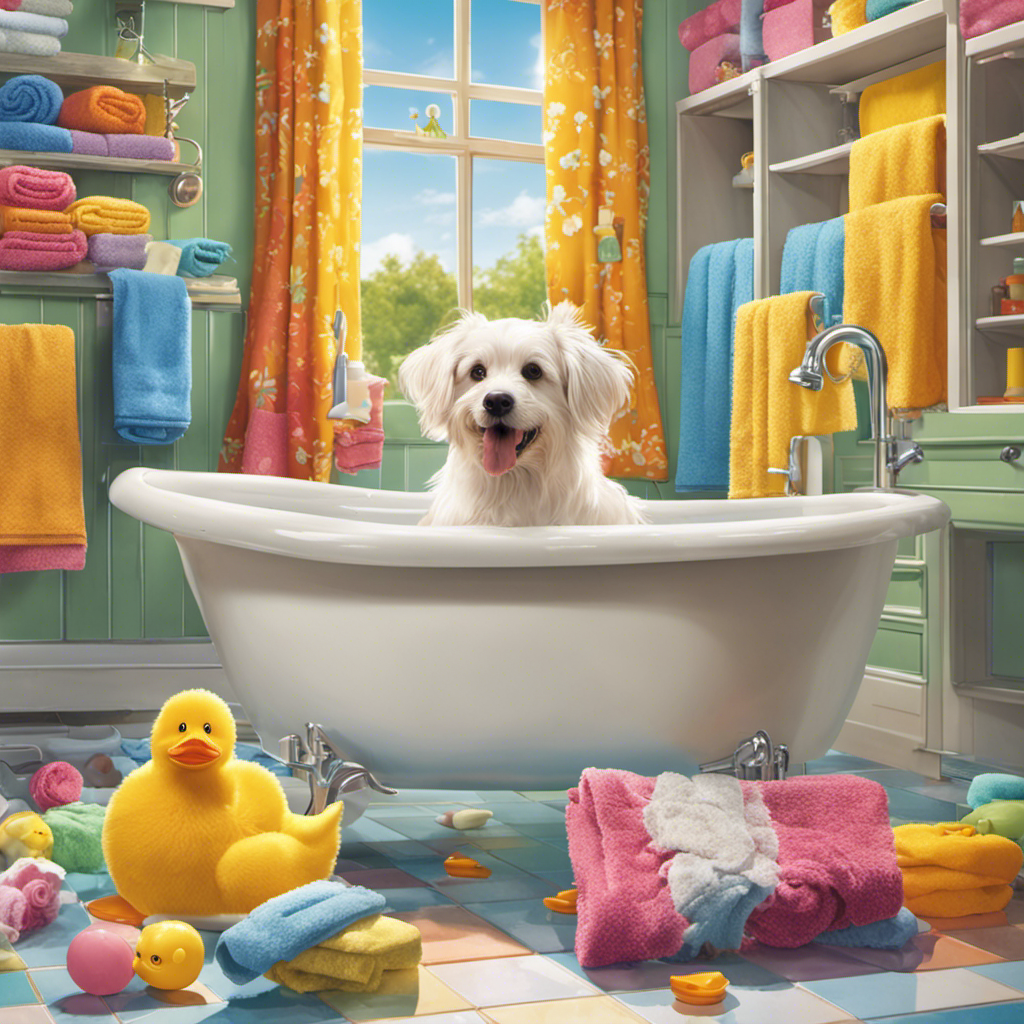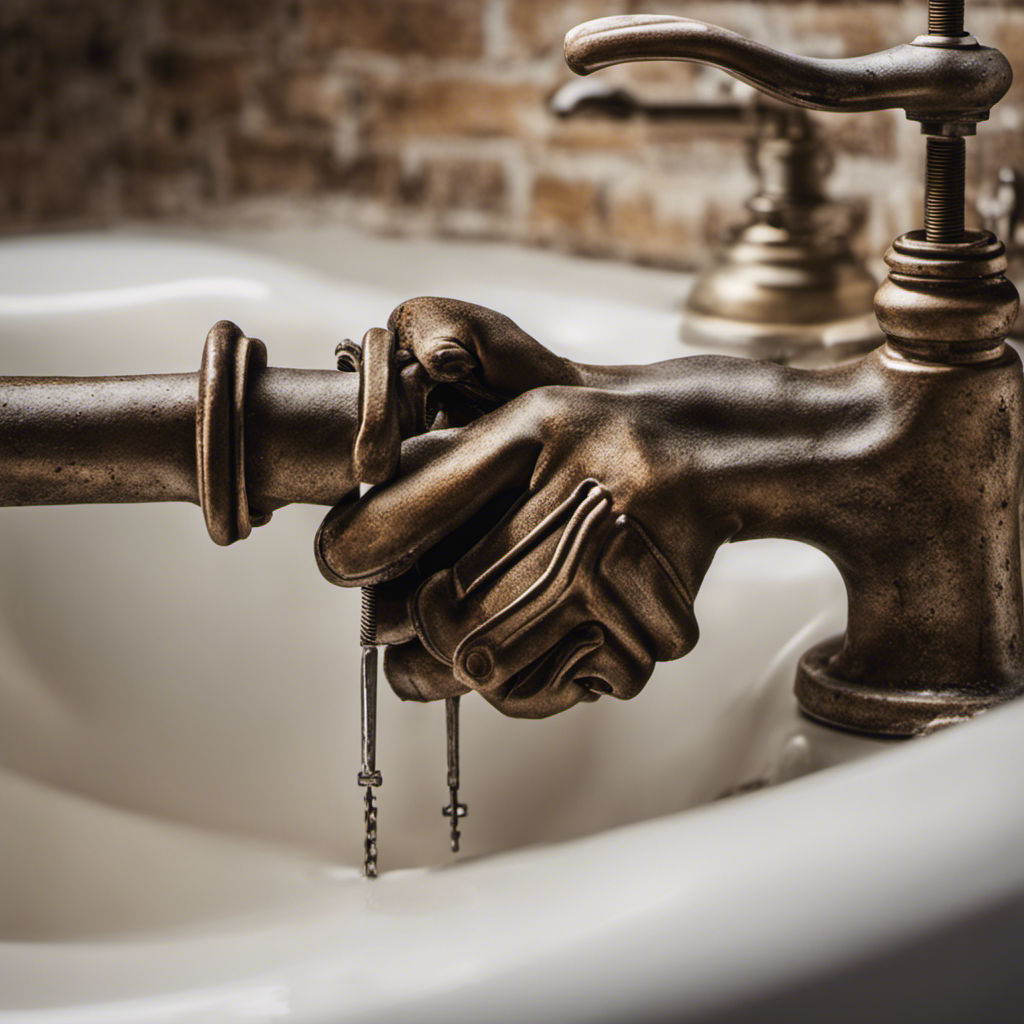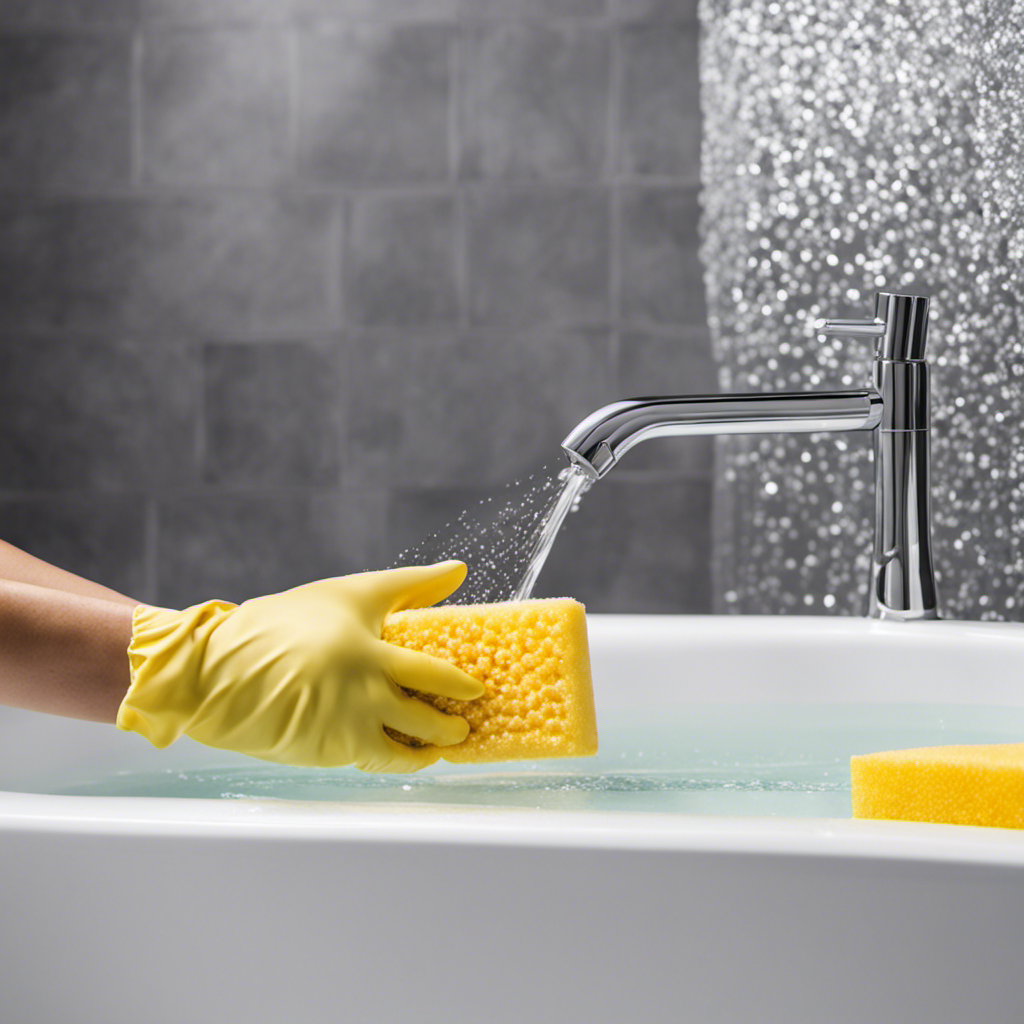Have you ever struggled to get your dog into the bathtub? Trust me, I’ve been there.
But fear not, because I’m here to share my foolproof tips and techniques on how to make bath time a breeze for both you and your furry friend.
From preparing the bathtub to safely lifting your dog and using proper grooming techniques, this article will equip you with all the knowledge you need to turn bath time into a wagging tail affair.
So let’s dive in and get your pup looking and feeling squeaky clean!
Key Takeaways
- Gather all necessary supplies, including a dog-friendly shampoo and a brush or comb to remove tangles or mats before the bath.
- Place a non-slip mat or towel in the bathtub to provide better traction for your dog and ensure the bathroom is clean and free from slippery objects.
- Use a gentle shampoo specifically formulated for dogs to avoid potential irritation or allergic reactions, and consult with a veterinarian for suitable shampoo if your dog has specific skin conditions or allergies.
- Thoroughly towel dry the dog after the bath, paying special attention to the ears, paws, and belly where moisture tends to accumulate, and consider using a blow dryer on a low, cool setting for dogs with thick coats while keeping the dryer at a safe distance to avoid burning the dog’s skin.
Preparing the Bathtub
First, you’ll need to make sure the bathtub’s drain is plugged and the water is warm. This will ensure a comfortable and safe environment for your dog during bath time.
Before bringing your dog into the bathroom, gather all the necessary supplies, including a dog-friendly shampoo. Choosing the right shampoo is crucial for your dog’s skin and coat health. Look for shampoos specifically formulated for dogs, avoiding those with harsh chemicals or fragrances that could irritate their sensitive skin. If your dog has any specific skin conditions or allergies, consult with your veterinarian to find the most suitable shampoo.
Additionally, consider using a non-slip mat or towel in the bathtub to prevent your dog from slipping and getting injured.
Gathering the Necessary Supplies
When it comes to bathing your dog, having the right tools is essential. The necessary supplies include a dog-specific shampoo, a brush or comb, and towels for drying.
It’s important to choose proper cleaning products that are safe for your dog’s skin and coat, and to follow any instructions or recommendations provided by your veterinarian.
Additionally, taking safety precautions during bath time is crucial to ensure a positive experience for both you and your dog.
Essential Bathing Tools
To get your dog in the bathtub, you’ll need some essential bathing tools. Here are the items you will need to ensure a successful bath time for your furry friend:
- Dog shampoo: Choose a gentle, specifically formulated shampoo for dogs to avoid any skin irritations.
- Rubber mat: Place a non-slip rubber mat in the bottom of the bathtub to prevent your dog from slipping and getting anxious.
- Towels: Have a stack of absorbent towels ready to dry your dog after the bath.
- Brush: Before the bath, use a brush to remove any tangles or mats in your dog’s coat.
- Treats: Reward your dog with treats throughout the bathing process to create positive associations with bath time.
By using these essential tools, you can establish a regular bathing schedule for your dog and make bath time a positive and enjoyable experience.
Now, let’s move on to discussing the proper cleaning products for your dog’s bath.
Proper Cleaning Products
Make sure you have the proper cleaning products, such as dog shampoo and conditioner, to keep your furry friend’s coat clean and healthy. When it comes to bathing your dog, using the right products is essential. Not all shampoos are suitable for dogs, as their pH levels are different from ours. It’s important to choose a shampoo specifically formulated for dogs to avoid any potential skin irritations or allergic reactions. Additionally, consider your dog’s specific needs, such as sensitive skin or dry coat, when selecting a shampoo. To help you make the right choice, here’s a table outlining some key factors to consider when choosing the right shampoo for your dog:
| Factor | Description | Example Product |
|---|---|---|
| Skin type | Consider if your dog has normal, dry, or sensitive skin. | Sensitive Skin Shampoo |
| Coat type | Different shampoos are designed for short, long, or curly coats. | Curly Coat Shampoo |
| Odor control | Some shampoos are specifically made to combat strong odors. | Odor Control Shampoo |
| Allergies | If your dog has allergies, look for hypoallergenic shampoos. | Hypoallergenic Shampoo |
Safety Precautions for Bathing
Before you start bathing your furry friend, it’s important to take safety precautions to ensure a positive and accident-free experience. Here are some techniques to prevent accidents during bath time:
- Secure the area: Make sure the bathroom is clean and free from any slippery objects that could cause your dog to slip or fall.
- Use a non-slip mat: Place a non-slip mat in the bathtub to provide your dog with better traction and prevent them from sliding around.
- Check the water temperature: Test the water with your hand or a thermometer to make sure it’s not too hot or too cold for your dog’s comfort.
- Use a gentle shampoo: Choose a dog-specific shampoo that is gentle on their skin to avoid any potential irritation or allergic reactions.
- Keep a firm grip: Maintain a secure grip on your dog throughout the bath to prevent them from jumping out or slipping.
Getting Your Dog Comfortable With the Bathroom
Once your dog feels at ease in the bathroom, you can start introducing them to the bathtub. It’s important to take things slow and make the experience as comfortable as possible for your furry friend.
Start by filling the tub with a small amount of lukewarm water, just enough to cover their paws. Allow your dog to explore and sniff the water, getting used to its presence. Offer treats and praise to create positive associations with the bathtub.
Gradually increase the water level over a few sessions, making sure to keep a calm and reassuring demeanor. Remember to never force your dog into the tub or use a high-pressure sprayer.
Patience and consistency are key when getting your dog comfortable with water and the bathtub.
Safely Lifting Your Dog Into the Bathtub
When lifting your pup into the tub, it’s important to use proper technique to ensure their safety. Here are some bathing techniques and tips to prevent slips:
- Place a non-slip mat in the bottom of the tub to provide traction for your dog’s paws.
- Gently lift your dog by supporting their chest and hindquarters, keeping their body close to yours.
Take your time and be patient, reassuring your pup with calm and soothing words.
- Use a leash or harness to provide extra stability and prevent your dog from jumping out of the tub.
- Gradually introduce your dog to the water by starting with a small amount and gradually increasing it.
By following these bathing techniques and preventing slips, you can make bath time a safe and enjoyable experience for your furry friend.
Remember to always prioritize their comfort and safety throughout the process.
Bathing and Grooming Techniques for Dogs
When it comes to bathing dogs, it’s important to consider the water temperature that is safe and comfortable for them. A warm water temperature, around 100-102 degrees Fahrenheit, is ideal for most dogs. This temperature helps to relax their muscles and makes the bathing experience more enjoyable for them.
After the bath, it’s crucial to properly dry your dog to prevent them from getting chilled or developing skin issues. Using a towel or a blow dryer on a low heat setting can help remove excess moisture and keep your furry friend cozy and healthy.
Water Temperature for Dogs
To make sure the water is comfortable for your dog, you should check the temperature before they get in the bathtub. Dogs have different sensitivities to temperature, so it’s important to find the right balance. Here are some tips to help you ensure the water is just right for your furry friend:
-
Use a thermometer to measure the water temperature. Aim for around 100-102 degrees Fahrenheit, which is similar to our body temperature.
-
Avoid extremes. Water that is too hot can scald your dog’s skin, while water that is too cold can be uncomfortable and cause shivering.
-
Test the water with your hand or elbow to make sure it feels warm and comfortable.
-
Consider your dog’s breed. Some breeds have thicker coats and may prefer slightly cooler water, while others with short coats may appreciate warmer water.
-
Pay attention to your dog’s behavior. If they seem anxious or uncomfortable, adjust the water temperature accordingly.
Drying After Bath
After bathing, it’s important to gently towel dry your furry friend to remove excess water from their coat. Proper dog grooming includes this crucial step to prevent your dog from catching a chill and to maintain a healthy coat.
Towel drying not only removes excess moisture, but it also helps to prevent matting and tangling of the fur. To effectively towel dry your dog, start by using a clean, absorbent towel and gently pat their coat. Avoid rubbing vigorously as this can cause damage to the hair follicles and irritate the skin.
Pay special attention to the ears, paws, and belly where moisture tends to accumulate. By towel drying your dog thoroughly, you can help maintain their overall health and keep their coat looking shiny and clean.
Drying and Rewarding Your Dog After Bath Time
Make sure you don’t forget to give your dog a treat and a towel rubdown after their bath. Drying your dog properly is essential to prevent them from getting cold and to keep their coat healthy. Here are some effective drying techniques to follow:
-
Use a large, absorbent towel to gently rub your dog’s fur, starting from their head and working your way down to their tail. This will help remove excess water and prevent matting.
-
If your dog has a thick coat, consider using a blow dryer on a low, cool setting. Make sure to keep the dryer at a safe distance to avoid burning your pet’s skin.
-
Use a grooming brush to gently comb through your dog’s fur while drying. This will help remove any tangles and ensure an even drying process.
-
Pay special attention to your dog’s ears and paws, as these areas tend to retain moisture. Use a clean, dry towel to gently dry these areas.
-
Finally, don’t forget to reward your dog with their favorite treats after the bath. This will help create a positive association with bath time and make the experience more enjoyable for your furry friend.
Conclusion
In conclusion, giving your dog a bath can be a challenging but rewarding experience. By following the steps outlined in this article, you can ensure that your furry friend stays clean and healthy.
The bathtub serves as a symbol of care and nurturing, as it becomes a space where you bond with your dog and show them love.
Remember to be patient and gentle, using the right techniques and supplies to make bath time a positive experience for both you and your canine companion.










